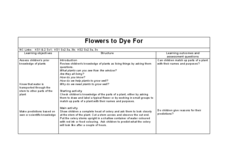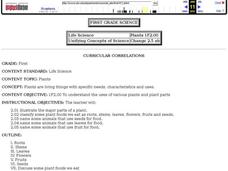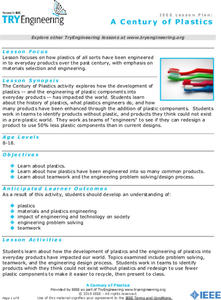Curated OER
Choosing a STEM Career
Students examine STEM careers and how they may progress in the future. In this research professionals lesson students write an essay about choosing a STEM career.
Curated OER
The Plant
Here is a good, basic, and solid lesson plan on the parts of a plant. Young biologists learn about the parts of a plant, and what each one does. Additionally, learners look at the parts of plants that are used by people and determine...
Curated OER
Heads or Tails? Studying Regeneration in Planaria
Students view a video on stem cells and regeneration. In this investigative lesson students complete a worksheet while viewing the video.
Curated OER
Flowers to Dye For
Students observe biology by completing a plant experiment in class. In this botany lesson, students discuss the anatomy related to a plant and how roots and stems are necessary to its survival. Students utilize food coloring and examine...
Curated OER
Plants
Students illustrate the major parts of a plant, classify some plant foods we eat as roots, stems, leaves, flowers, fruits and seeds. They also name some animals that use seeds, leaves, and fruit for food.
Institute of Electrical and Electronics Engineers
A Century of Plastics
After reading about polymer materials, engineer trainees examine how plastics have been integrated into everyday products. In groups, they compile a list of products made entirely without plastics and then, as a closing activity, try to...
Institute of Electrical and Electronics Engineers
Build a Big Wheel
What does it take to prepare for a construction project? In an engineering instructional activity, youngsters examine how a Ferris wheel can turn and carry a load without falling apart. After reading up on big wheel designs, they create...
Institute of Electrical and Electronics Engineers
Cast Your Vote
In a simple but unique lesson, youngsters learn about the history of voting systems. They then collaborate in groups to develop a new honest and consistent voting method. A class-wide poll is taken, evaluating the designs of other...
Institute of Electrical and Electronics Engineers
Playing with Parachutes
This lesson certainly will not be a drag! Little engineers design parachutes that make use of air resistance and, as a result, slow the descent of the payload as much as possible. It is an opportunity to teach about many motion concepts:...
Institute of Electrical and Electronics Engineers
Water Fountain
Thorough instructions are given to guide you through making a demonstration hydraulic pump from two plastic soda bottles. After using the resource to teach your class about Pascal's and Bernoulli's principles, turn them loose in groups...
Curated OER
Long-Stemmed Lilies
Students examine Easter traditions and symbols. They investigate botanical information about lilies,such as numbers and shapes of petals, sepals, stamens, pistils and create an accurate replica pot of lilies.
Curated OER
What Is It?
Play the game of Tag and differentiate between plants and animals. Explore the characteristics of plants. Identify the major parts of plants (e.g., seeds, stem, pistil) and describe their basic functions. Compare the requirements of some...
Curated OER
Flowers
Students study the parts of any flower and the conditions under which the plant thrives. They collect photographs and drawings to help create an accurate, realistic sculpture. They illustrate and label the flower parts and take photos of...
Curated OER
Plant Parts and their Function
Discover why plants are important to our world. View plant parts and categorize them as stems or buds. Students do a cut and paste of pictures of plants into correct categories. Students also plant a carrot top,and record the growth and...
Curated OER
Cloning Around
Review concepts of cloning and genetic engineering and participate in a round-table discussion based on the ethics and potential of cloning with your class. Each learner then writes a formal essay on the topic, stemming from the debate.
Curated OER
Getting Up the Nerve
Students examine the basics of the nervous system through an interactive program. They discover how the brain is linked to muscle movement. They can test cells through the interactive program to see how it reacts to different stimuli.
Curated OER
How to Make an Artificial Organ
Students design bionic organs or limbs. In this medical technology lesson, students view a video about artificial organs and prosthetic limbs. They research the medical technology behind these advances and work to design a organ or limb...
Curated OER
Celery
Here is a wonderful series of lesson plans that use celery to faciliate all sorts of learning. By the end of the lessons, youngsters should know how celery is grown, how celery is used in homes and restaurants, and they will understand...
Curated OER
The Way We Were: Embryological Development and Disease
Students use microscopes to study live fish embryos and animated diagrams of cell division on the Internet. They see that scientists rely on technology to enhance the gathering and manipulation of data. They create web pages on cloning.
Curated OER
Edible Bug Project
Students recognize the characteristics of insects. In this edible bugs activity, students observe the body parts of an insect. Students create an edible insect using a grape, carrot sticks and sorrel stems and leaves. Students share...
Baylor College
What Is a Neuron?
Your class won't get on your nerves while doing this modeling activity! After teaching the structure and function of a neuron using the included diagrams, give individuals some clay and chenille stems so that they can make their own...
TED-Ed
How to Speak Monkey: The Language of Cotton-Top Tamarins
Tamarin monkey language can be categorized by stem upsweep, duration, peak frequency, and frequency change. Although other complex terminology is used to describe the 38 calls of this species, the video is easy to follow and a...
STEM for Teachers
Electromagnificent
This physics pun really hertz, but this STEM lesson plan can help. The inquiry-based activity has young scientists create a testable question about electromagnetic strength; plan and implement their own experiments; and record and...
Mascil Project
Design and Build Your Own Vacuum Cleaner, Hair Dryer or Toy Car
No vacuum cleaner? No problem, just build your own. Scholars apply knowledge of currents to build a model of either a vacuum clear, a hair dryer, or a toy car. While the class completes the activity, instructors consider gender...
Other popular searches
- Stem and Leaf Plots
- Stem Cells
- Stem and Leaf
- Brain Stem
- Stem Cell Research
- Roots, Stems and Leaves
- Stem and Leaf Plots
- Roots Stems and Leaves
- Cell Biology Stem Cells
- Plant Stems
- Flower Stems
- Human Stem Cells






















